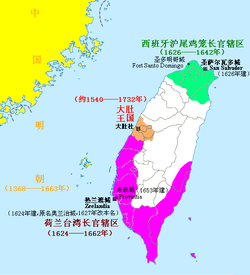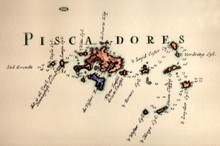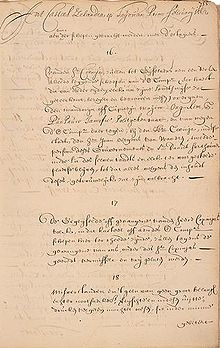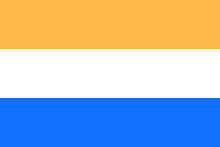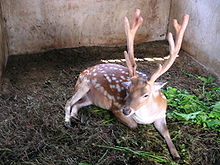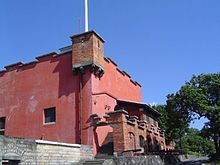- Dutch Formosa
-
Government of Formosa
Gouvernement FormosaDutch colony ← 
←
1624–1662  →
→

Flag Coat of arms The location of Dutch Formosa (in magenta) on Taiwan Capital Fort Zeelandia Language(s) Dutch, Formosan languages Religion Protestantism (Dutch Reformed Church)
native animistic religionGovernment Colony Governor - 1624–1625 Marten Sonk - 1656–1662 Frederick Coyett Historical era Age of Discovery - Established 1624 - Siege of Fort Zeelandia 1661–1662 - Surrender of Fort Zeelandia February 1, 1662 1662 Currency Spanish real 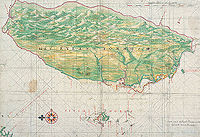
Part of a series on the History of Taiwan Prehistory 50,000 BC – AD 1624 Kingdom of Middag 1540 – 1732 Dutch rule, Formosa 1624 – 1662 Spanish rule, Formosa 1626 – 1642 Kingdom of Tungning 1662 – 1683 Qing Dynasty rule 1683 – 1895 Republic of Formosa 1895 Japanese rule 1895 – 1945 Republic of China rule 1945 – present Categories
- Cultural history
- Diplomatic history
- Economic history
- Educational history
- Military history
- Political history
Lists
Related
- History of Republic of China (1949-present) •
History of Kaohsiung • History of Taipei - Archaeological sites
- Taiwan independence • Taiwan Province, PRC
Dutch Formosa refers to the period of colonial Dutch government on Formosa (now known as Taiwan), lasting from 1624 to 1662. In the context of the Age of Discovery the Dutch East India Company established its presence on Taiwan to trade with China and Japan, and also to interdict Portuguese and Spanish trade and colonial activities in East Asia.
The time of Dutch rule saw economic development in Taiwan, including both large-scale hunting of deer and the cultivation of rice and sugar by imported labour from Fujian in China. The government also attempted to convert the aboriginal inhabitants to Christianity and suppress some cultural activities they found disagreeable (such as forced abortion and habitual nakedness) -in other words, to "civilise" the inhabitants of the island.
However, they were not universally welcomed and uprisings by both aborigines and recent Han Chinese arrivals were crushed brutally by the Dutch military on more than one occasion. The colonial period was brought to an end by the invasion of Koxinga's army after just 37 years.
History
Background
At the beginning of the 17th century the forces of Catholic Spain and Portugal were in opposition to those of the Netherlands and England, both mainly Protestant, often resulting in open warfare in Europe and in their possessions in Asia. The Dutch first attempted to trade with China in 1601[1] but were rebuffed by the Chinese authorities, who were already engaged in trade with the Portuguese at Macau from 1535. In a 1604 expedition from Batavia (the central base of the Dutch in Asia), Admiral van Warwijk set out to attack Macau, but his force was waylaid by a typhoon, driving them to the Pescadores (now known as Penghu). Once there, the admiral attempted to negotiate trade terms with the Chinese on the mainland, but was asked to pay an exorbitant fee for the privilege of an interview. Surrounded by a vastly superior Chinese fleet, he left without achieving any of his aims.[2]
In 1622 after another unsuccessful Dutch attack on Macau ( trade post of Portugal from 1557 ) the fleet sailed to the Pescadores, this time intentionally, and proceeded to set up a base there at Makung. They built a fort there with forced labour recruited from the local Chinese population; their oversight was reportedly so severe and rations so short that 1,300 of the 1,500 Chinese enslaved died in the process of construction.[3] However, the Ming authorities warned the Dutch that the Pescadores were Chinese territory, and suggested that they instead move to Taiwan and establish themselves there. The same year a ship named the Golden Lion (Dutch: Gouden Leeuw) was wrecked at Lamey just off the southwest coast of Taiwan; the survivors were slaughtered by the native inhabitants.[4] The following year, 1623, Dutch traders in search of an Asian base first arrived on the island, intending to use the island as a station for Dutch commerce with Japan and the coastal areas of China.
Early years (1624–1625)
On deciding to set up in Taiwan and in common with standard practice at the time, the Dutch built a defensive fort to act as a base of operations. This was built on the sandy peninsula of Tayouan[5] (now part of mainland Taiwan, in the current-day district of Anping). The site chosen was accessible from the sea and had good sightlines for defensive purposes, but lacked fresh water, which had to be shipped from the mainland.[5]
Growing control, pacification of the aborigines (1626–1636)
The first order of business was to punish villages that had violently opposed the Dutch and unite the aborigines in allegiance with the VOC. The first punitive expedition was against the villages of Bakloan and Mattau, north of Saccam near Tayowan. The Mattau campaign had been easier than expected and the tribe submitted after having their village razed by fire. The campaign also served as a threat to other villages from Tirosen (Chiayi) to Longkiau (Hengchun). While the pacification campaign continued in Formosa, at sea, relations with the Chinese were strained by the Dutch attemps to tax ships in the Taiwan Strait, war eventually broke out between the Ming and the Dutch and the Chinese Admiral Zheng Zhilong defeated the Dutch at the Battle of Liaoluo Bay in 1633.
Pax Hollandica and the ousting of the Spanish (1636–1642)
Following the pacification campaigns of 1635–6, more and more villages came to the Dutch to swear allegiance, sometimes out of fear of Dutch military action, and sometimes for the benefits which Dutch protection could bring (food and security). These villages stretched from Longkiau in the south (125 km from the Dutch base at Fort Zeelandia to Favorlang in central Taiwan, 90 km to the north of Fort Zeelandia. The relative calm of this period has been called the Pax Hollandica (Dutch Peace) by some commentators[6] (a reference to the Pax Romana).
One area not under their control was the north of the island, which from 1626 had been under Spanish sway, with their two settlements at Tamsuy and Keelung. The fortification at Keelung was abandoned because the Spanish lacked the resources to maintain it, but Fort Santo Domingo in Tamsuy was seen as a major obstacle to Dutch ambitions on the island and the region in general.
In 1642, the Dutch sent an expedition of soldiers and aboriginal warriors in ships to Tamsuy, managing to dislodge the small Spanish contingent from their fortress and drive them from Taiwan. Following this victory, the Dutch set about bringing the northern villages under their banner in a similar way to the pacification campaign carried out in the previous decade in the south.
Growing Chinese presence and the Guo Huaiyi Rebellion (1643–1659)
The Dutch began to encourage large-scale Chinese immigration to the island, mainly from Fujian. Most of the immigrants were young single males who were discouraged from staying on the island often referred to by Han as "The Gate of Hell" for its reputation in taking the lives of sailors and explorers.[7] After one uprising by Han Chinese in 1640, the Guo Huaiyi Rebellion in 1652 saw an organised insurrection against the Dutch, fuelled by anger over punitive taxes and corrupt officials. The Dutch again put down the revolt hard, with fully 25% of those participating in the rebellion being killed over a period of a couple of weeks.[6]
Siege of Zeelandia and the end of Dutch government on Formosa (1660–1662)
In 1661, a naval fleet of 200 ships, led by the Ming loyalist Koxinga, landed at Lu'ermen to attack Taiwan in order to destroy and oust the Dutch from Zeelandia. Following a nine month siege, Koxinga captured the Dutch Fort Zeelandia and defeated the Dutch. Koxinga then forced the local representatives of the Dutch East India Company to sign a peace treaty at Zeelandia on 1 February 1662, and leave Taiwan. From then on, Taiwan became Koxinga's base for the Kingdom of Tungning.
Coda: The Dutch retake Keelung (1664–1668)
After being ousted from Taiwan the Dutch allied with the new Qing Dynasty in China against the Zheng regime in Taiwan. Following some skirmishes the Dutch retook the northern fortress at Keelung in 1664.[8] Zheng Jing sent troops to dislodge the Dutch, but they were unsuccessful. The Dutch held out at Keelung until 1668, when aborigine resistance (likely incited by Zheng Jing) and the lack of progress in retaking any other parts of the island persuaded them to give up their last stronghold and retreat from Taiwan altogether.[9]
Government
The Dutch claimed the entirety of the island, but because of the inaccessibility of the central mountain range the extent of their control was limited to the plains on the west coast, plus isolated pockets on the east coast. This territory was acquired from 1624 to 1642, with most of the villages being required to swear allegiance to the Dutch and then largely being left to govern themselves. The manner of acknowledging Dutch lordship was to bring a small native plant (often betel nut or coconut) planted in earth from that particular town to the Governor, signifying the granting of the land to the Dutch. The Governor would then award the village leader a robe and a staff as symbols of office and a Prinsenvlag ("Prince's Flag", the flag of William the Silent) to display in their village.
Governor of Formosa
The Governor of Formosa (Dutch: Gouverneur van Formosa; Chinese: 台灣長官) was the head of government. Appointed by the Governor-General of the Dutch East Indies in Batavia (modern-day Jakarta, Indonesia), the Governor of Formosa was empowered to legislate, collect taxes, wage war and declare peace on behalf of the Dutch East India Company (VOC) and therefore by extension the Dutch state.
He was assisted in his duties by the Council of Tayouan, a group made up of the various worthies in residence in Tayouan. The President of this council was the second-in-command to the Governor, and would take over his duties if the Governor died or was incapacitated. The Governor's residence was in Fort Zeelandia on Tayouan (then an island, now the Anping District of Tainan City). There were a total of twelve Governors during the Dutch colonial era.[10]
Economy
The Tayouan factory (as VOC trading posts were called) was to become the second-most profitable factory in the whole of the Dutch East Indies (after the post at Hirado/Dejima),[11] although it took 22 years for the colony to first return a profit.[12] Benefitting from triangular trade between themselves, the Chinese and the Japanese, plus exploiting the natural resources of Formosa, the Dutch were able to turn the malarial sub-tropical bay into a lucrative asset. A cash economy was introduced (using the Spanish real,which is used by VOC) and the period also saw the first serious attempts in the island's history to develop it economically.[13]
Trade
The original intention of setting up in southern Formosa was to provide a base for trading with China and Japan, as well as interfering with Portuguese and Spanish trade in the region. Goods traded included silks from China and silver from Japan, among many other things. After establishing their fortress the Dutch realised the potential of the vast herds of deer which roamed the western plains of the island. Apart from venison, which was mainly sold domestically, the tough deer skins were highly prized by the Japanese, who used them to make samurai armour.
Later the Dutch also traded in the agricultural produce of the island (including sugar and rice) after large-scale cultivation was implemented by the colonists utilising imported labour from Fujian.
Hunting
The Dutch originally sought to use their castle Fort Zeelandia at Tayowan (Anping) as a trading base between Japan and China, but soon realized the potential of the huge deer populations that roamed in herds of thousands along the alluvial plains of Taiwan's western regions. Deer were in high demand by the Japanese who were willing to pay premium for use of the hides in samurai armor. Other parts of the deer were sold to Chinese traders for meat and medical use. The Dutch paid aborigines for the deer brought to them and tried to manage the deer stocks to keep up with demand. Unfortunately the deer the aborigines had relied on for their livelihoods began to disappear, forcing the aborigines to adopt new means of survival.
Agriculture
The Dutch also employed Chinese to farm sugarcane and rice for export; some of this rice and sugar was exported as far as the markets of Persia.[14] Attempts to persuade aboriginal tribesmen to give up hunting and adopt a sedentary farming lifestyle were unsuccessful because "for them, farming had two major drawbacks: first, according to the traditional sexual division of labor, it was women's work; second, it was labor-intensive drudgery."[15] The Dutch therefore imported labour from China, and the era was the first to see mass Chinese immigration to the island, with one commentator estimating that 50-60,000 Chinese settled in Taiwan during the 37 years of Dutch rule.[16] These settlers were encouraged with free transportation to the island, often on Dutch ships, and tools, oxen and seed to start farming.[13] In return, the Dutch took a tenth of agricultural production as a tax.[13]
Head tax
A head tax was levied on all Chinese residents over the age of six.[17] This tax was considered particularly burdensome by the Chinese as there had been no taxation prior to Dutch occupation of the island. Coupled with restrictive land tenancy policies and extortion by Dutch soldiers, the tax provided grounds for the major insurrections of 1640 and 1652.[17]
Demographics
Prior to the arrival of the Dutch colonists, Taiwan was almost exclusively populated by Taiwanese aborigines; Austronesian peoples who lived in a hunter-gatherer society while also practicing swidden agriculture. It is difficult to arrive at an estimate of the numbers of these native Formosans when the Dutch arrived, as there was no island-wide authority in a position to count the population, while the aborigines themselves did not keep written records. Even at the extent of greatest Dutch control in the 1650s there were still large regions of the island outside the pale of Dutch authority, meaning that any statistics given necessarily relate only to the area of Dutch suzerainty.
Ethnicity
The population of Dutch Formosa was composed of three main groups; the aborigines, the Dutch contingent, and the Chinese. There were also a number of Spanish people resident in the north of the island between 1626 and 1642 in the area around Keelung and Tamsui. At times there were also a handful of Japanese trader-pirates known as Wakō operating out of coastal areas outside Dutch control.
The Aborigines
The native Formosan peoples had been in Taiwan for thousands of years before the Dutch arrived. Estimates of the total numbers of aborigines in Taiwan are difficult to come by, but one commentator suggests that there were 150,000 over the entire island during the Dutch era. They lived in villages with populations ranging from a couple of hundred up to around 2,000 people for the biggest towns, with different groups speaking different Formosan languages which were not mutually intelligible.
The Dutch
The Dutch contingent was initially composed mostly of soldiers, with some slaves and other workers from the other Dutch colonies, particularly the area around Batavia (current day Jakarta). The number of soldiers stationed on the island waxed and waned according to the military needs of the colony, from a low of 180 troops in the early days to a high of 1,800 shortly before Koxinga's invasion. There were also a number of other personnel, from traders and merchants to missionaries and schoolteachers, plus the Dutch brought with them slaves from their other colonies, who mainly served as personal slaves for important Dutch people.
The Chinese
When the Dutch arrived in Taiwan there was already a network of Chinese traders living on the island, buying merchandise (particularly deer products) from the native Formosans. This network has been estimated at some 1,000–1,500 people, almost all male, most of whom were seasonal residents in Taiwan, returning to Fujian in the off-season. Beginning in the 1640s the Dutch began to encourage large-scale immigration of Chinese to Formosa, providing not only transportation from Fujian, but also oxen and seed for the new immigrants to get started in agriculture. Estimates of the numbers of Chinese in Taiwan at the end of the Dutch era vary widely, from 10-15,000 up to 50-60,000, although the lower end of that scale seems more likely.
Religion
One of the key pillars of the Dutch colonial era was conversion of the natives to Christianity. From the descriptions of the early missionaries, the native religion was animist in nature, in one case presided over by priestesses called Inibs.
The Formosans also practiced various activities which the Dutch perceived as sinful or at least uncivilised, including mandatory abortion (by massage) for women under 37,[18] frequent marital infidelity,[18] non-observation of the Christian Sabbath and general nakedness.
Education
The missionaries were also responsible for setting up schools in the villages under Dutch control, teaching not only the religion of the colonists but also other skills such as reading and writing. Prior to Dutch arrival the native inhabitants did not use writing, and the missionaries created a number of romanization schemes for the various Formosan languages. Experiments were made with teaching native children the Dutch language, however these were abandoned fairly rapidly after they failed to produce good results. At least one Formosan received an education in the Netherlands; he eventually married a Dutch woman and was apparently well integrated into Dutch society.[19]
Legacy
Today, their legacy in Taiwan is visible in Anping District of Tainan City where the remains of their Castle Zeelandia are preserved, in Tainan City itself where their Fort Provintia is still the main structure of what is now called Red-topped Tower, and finally in Tamsui where Fort Anthonio[20] (part of the Fort San Domingo museum complex) still stands as the best preserved Redoubt (minor fort) of the Dutch East India Company anywhere in the world. The building was later used by the British consulate[21] until the United Kingdom severed ties with the KMT (Chinese Nationalist Party or Kuomintang) regime and its formal relationship with Taiwan.
However, perhaps the most lasting result of Dutch rule is the immigration of Chinese to the island. At the start of the Dutch era, there were estimated to be between 1,000-1,500 Chinese in Taiwan, mostly traders living in aborigine villages.[22] By the end of the colonial period, Taiwan had many Chinese villages holding tens of thousands of people in total, and the ethnic balance of the island was already well on the way to favouring the newly arrived Chinese over the aboriginal tribes.[6]
See also
- History of Taiwan
- Fort Zeelandia
- Taiwanese aborigines: The European period
- Dutch East India Company
- Koxinga
- Kingdom of Tungning
- Spanish Formosa
Notes
- ^ Ts'ao 1979, p. 28.
- ^ Davidson, p. 10.
- ^ Davidson, p. 11.
- ^ Blussé 2000, p. 144.
- ^ a b "Zeelandia and Provintia". National Palace Museum. http://www.npm.gov.tw/exhbition/formosa/english/05.htm. Retrieved 2008-09-22.
- ^ a b c Andrade, Tonio (2005). How Taiwan Became Chinese: Dutch, Spanish and Han Colonization in the Seventeenth Century. Columbia University Press. http://www.gutenberg-e.org/andrade/.
- ^ Keliher, p. 32.
- ^ Wills, p. 276.
- ^ Wills, pp. 288–9
- ^ William Campbell (1903). Formosa under the Dutch: Described from Contemporary Records.
- ^ Knapp, p. 14.
- ^ Van Veen.
- ^ a b c Roy, p. 15.
- ^ Gramman
- ^ Shepherd 1993 p. 366.
- ^ Knapp, p. 18.
- ^ a b Roy, p. 16.
- ^ a b Shepherd 1995.
- ^ Everts, p. 151.
- ^ Guo, Elizabeth & Kennedy, Brian. "Tale of Two Towns". News Review. http://www.newsreview.com/chico/Content?oid=692352. Retrieved 2008-09-10.
- ^ "Sightseeing Introduction to Hongmaocheng" (in Chinese). http://travel.network.com.tw/tourguide/point/showpage/433.html. Retrieved 2008-09-21.
- ^ Shepherd 1993.
References
- Andrade, Tonio (2005). How Taiwan Became Chinese: Dutch, Spanish and Han Colonization in the Seventeenth Century. Columbia University Press. http://www.gutenberg-e.org/andrade/.
- Blussé, Leonard (1984). "Dutch Protestant Missionaries as Protagonists of the Territorial Expansion of the VOC on Formosa". In Kooiman, van den Muijzenburg & van der Veer. Conversion, Competition and Conflict. Amsterdam: Free University Press.
- Blussé, Leonard (1994). "Retribution and Remorse: The Interaction between the Administration and the Protestant Mission in Early Colonial Formosa". In Prakash, Gyan. After Colonialism: Imperial Histories and Postcolonial Displacement. Princeton University Press. ISBN 978-0691037424.
- Blussé, Leonard (2000). "The Cave of the Black Spirits". In Blundell, David. Austronesian Taiwan. California: University of California. ISBN 0-936127-09-0.
- Blussé, Leonard; Everts, Natalie; Frech, Evelien, eds (1999). The Formosan Encounter: Notes on Formosa's Aboriginal Society: A Selection of Documents from Dutch Archival Sources. Vol. I. Shung Ye Museum of Formosan Aborigines. ISBN 957-99767-2-4.
- Blussé, Leonard; Everts, Natalie, eds (2000). The Formosan Encounter: Notes on Formosa's Aboriginal Society: A Selection of Documents from Dutch Archival Sources. Vol. II. Shung Ye Museum of Formosan Aborigines. ISBN 957-99767-7-5.
- Blussé, Leonard; Everts, Natalie, eds (2006). The Formosan Encounter: Notes on Formosa's Aboriginal Society: A Selection of Documents from Dutch Archival Sources. Vol. III. Shung Ye Museum of Formosan Aborigines. ISBN 957-30287-3-5.
- Campbell, William (1996) [1888]. The Gospel of St Matthew in Formosan (Sinkang Dialect) with Corresponding Versions in Dutch and English; Edited from Gravius's Edition of 1661. Taipei, Taiwan: Southern Materials Center. ISBN 957-638-299-8.
- Campbell, William (2001) [1903]. Formosa under the Dutch: Described from Contemporary Records. Taipei, Taiwan: Southern Materials Center. ISBN 957-638-083-9.
- Chin Hsin-hui (2008). The Colonial 'Civilizing Process' in Dutch Formosa, 1624-1662. Brill. ISBN 978-9004165076.
- Copper, John F. (2003). Taiwan: Nation-State or Province?. Nations of the Modern World (4th ed.). Westview Press. ISBN 978-0813339559.
- Copper, John F. (2007). Historical Dictionary of Taiwan (3rd Edition ed.). Metuchen, New Jersey: Scarecrow Press. ISBN 978-0810856004.
- Coyett, Frederick (1675) (in Dutch). 't Verwaerloosde Formosa (Neglected Formosa).
- Davidson, James M. (2005) [1903]. The Island of Formosa Past and Present. Taipei, Taiwan: Southern Materials Center. ISBN 957-638-124-X.
- Everts, Natalie (2000). "Jacob Lamay van Taywan: An Indigenous Formosan Who Became an Amsterdam Citizen". In Blundell, David. Austronesian Taiwan. California: University of California. ISBN 0-936127-09-0.
- Gramann, Kristof (1958). Dutch-Asiatic Trade, 1620–1740. The Hague: M. Nijhoff.
- Heyns, Pol; Cheng, Wei-chung, eds (2005). Dutch Formosan Placard-book, Marriage, and Baptism Records. Taipei: The Ts'ao Yung-ho Foundation for Culture and Education. ISBN 986-7602-01-3.
- Imbault-Huart, Camille-Clément (1995) [1893] (in French). L'île Formose: Histoire et Déscription. Taipei: Southern Materials Center. ISBN 957-638-291-2.
- Keliher, Macabe (2003). Out of China or Yu Yonghe's Tales of Formosa: A History of 17th Century Taiwan. Taipei: Southern Materials Center. ISBN 957-6386292.
- Knapp, Ronald G. (1995) [1980]. China's Island Frontier: Studies in the Historical Geography of Taiwan. Hawaii: University of Hawaii Press. ISBN 957-638-334-X.
- Roy, Denny (2003). Taiwan: A Political History. Ithaca, New York: Cornell University Press. ISBN 0-8014-8805-2.
- Shepherd, John Robert (1993). Statecraft and Political Economy on the Taiwan Frontier, 1600–1800. Stanford University Press. ISBN 978-0804720663.
- Shepherd, John Robert (1995). Marriage and Mandatory Abortion Among the Seventeenth Century Siraya. American Ethnological Society Mongraph Series, No. 6. Arlington, Virginia, USA: American Anthropological Association.
- Ts'ao, Yung-ho (2006) [1979] (in Chinese). Taiwan zaoqi lishi yanjiu (Research into Early Taiwan History). Taipei: Lianjing. ISBN 978-957-08-0698-4.
- Ts'ao, Yung-ho (2000) (in Chinese). Taiwan zaoqi lishi yanjiu xuji (Research into Early Taiwan History: Continued). Taipei: Lianjing. ISBN 957-08-2153-1.
- van Veen, Ernst (2003). "How the Dutch Ran a Seveenteenth-Century Colony: The Occupation and Loss of Formosa 1624-1662". In Blussé, Leonard. Around and About Formosa. Southern Materials Center. ISBN 986-7602-00-5.
- Wills, John E. (2000). "The Dutch Reoccupation of Chi-lung, 1664-1668". In Blundell, David. Austronesian Taiwan. California: University of California. ISBN 0-936127-09-0.
Further reading
- Andrade, Tonio (2006). "The Rise and Fall of Dutch Taiwan, 1624-1662: Cooperative Colonization and the Statist Model of European Expansion". Journal of World History 17 (4): 429–450. doi:10.1353/jwh.2006.0052.
- Valentijn, François (1724–26) (in Dutch). Oud en nieuw Oost-Indiën. Dordrecht: J. van Braam.
- Wills, John E. Jr. (2005). Pepper, Guns, and Parleys: The Dutch East India Company and China, 1622-1681. Figueroa Press. ISBN 978-1932800081.
External links
- Formosa in 17th Century
- Dutch Governor of Taiwan (Mandarin)
- Text of the Peace Treaty of 1662
- Exhibition on Dutch period of Taiwan in Tamsui
Preceded by
Prehistory of Taiwan
until 1624Dutch Formosa
1624–1662Succeeded by
Kingdom of Tungning
1662–1683Dutch Empire Colonies and trading posts of the Dutch East India Company (1602-1798) GovernoratesAmbon · Banda · Batavia · Cape Colony · Ceylon · Coromandel · Formosa · Northeast coast of Java · Makassar · Malacca · MoluccasDirectoratesCommandmentsResidenciesColonies and trading posts of the Dutch West India Company (1621-1792) Colonies in the AmericasAcadia · Berbice† · Cayenne · Curaçao and Dependencies · Demerara · Essequibo · Brazil · New Netherland · Pomeroon · Sint Eustatius and Dependencies · Suriname‡ · Tobago · Virgin IslandsTrading posts in Africa† Governed by the Society of Berbice · ‡ Governed by the Society of SurinameSettlements of the Noordsche Compagnie (1614-1642) SettlementsColonies of the Kingdom of the Netherlands (1815-1962) Until 1825Until 1853Until 1872Until 1945Until 1954Until 1962† Became constituent countries of the Kingdom of the Netherlands; Suriname gained full independence in 1975, Curaçao and Dependencies was renamed to the Netherlands Antilles, which was eventually dissolved in 2010.Kingdom of the Netherlands (1954-Present) Constituent countries Dutch Formosa
Dutch FormosaEvents Pacification Campaign · Battle of Liaoluo Bay · Lamey Island Massacre · Guo Huaiyi Rebellion · Siege of Fort Zeelandia
Places Villages Fortifications People Governors Missionaries Others Categories:- Former countries in East Asia
- Former Dutch colonies
- States and territories established in 1624
- States and territories disestablished in 1662
- Dutch Formosa
- History of Taiwan
- European colonisation in Asia
- 1662 disestablishments
- 17th century in Taiwan
- Cultural history
Wikimedia Foundation. 2010.

